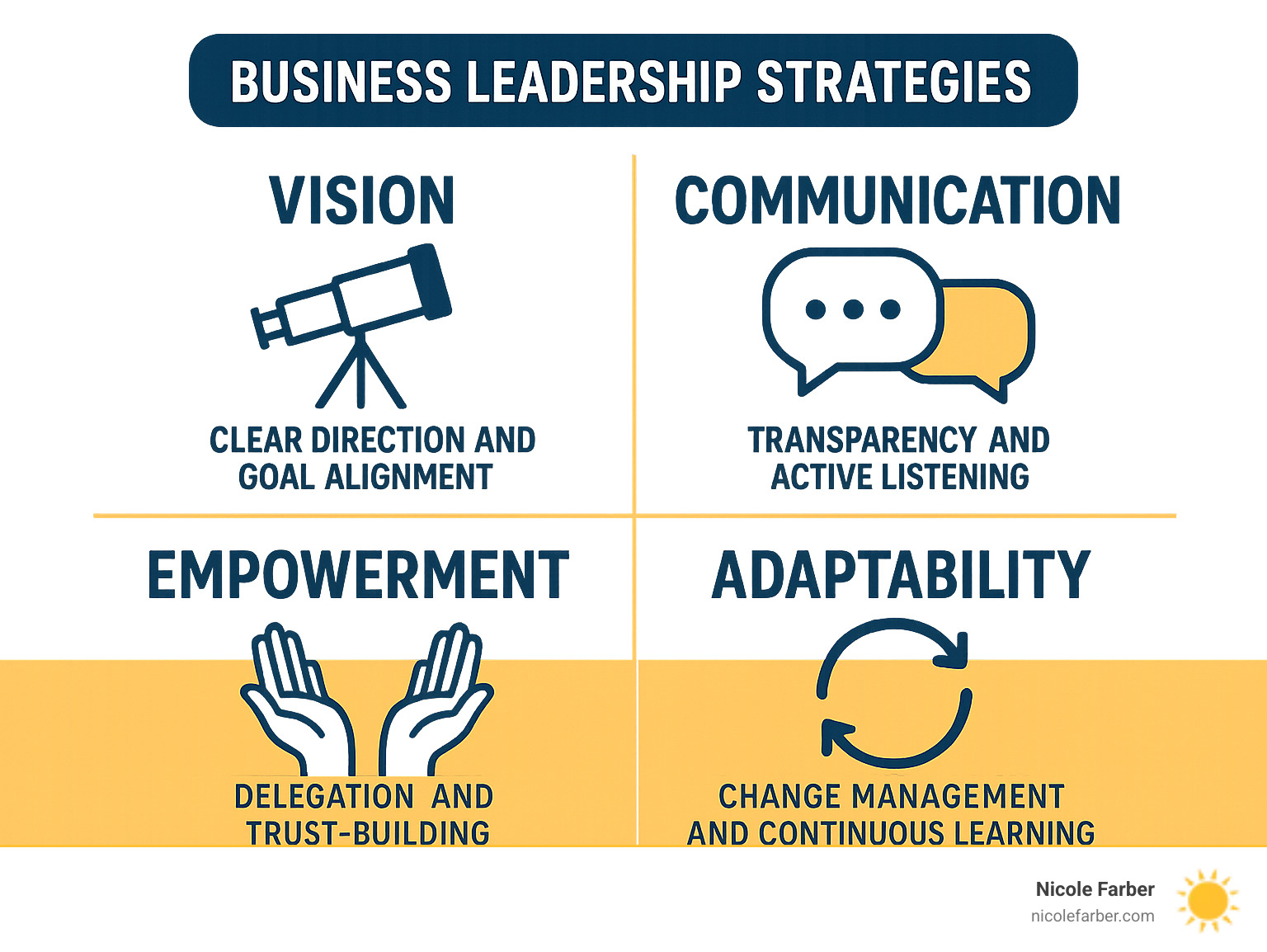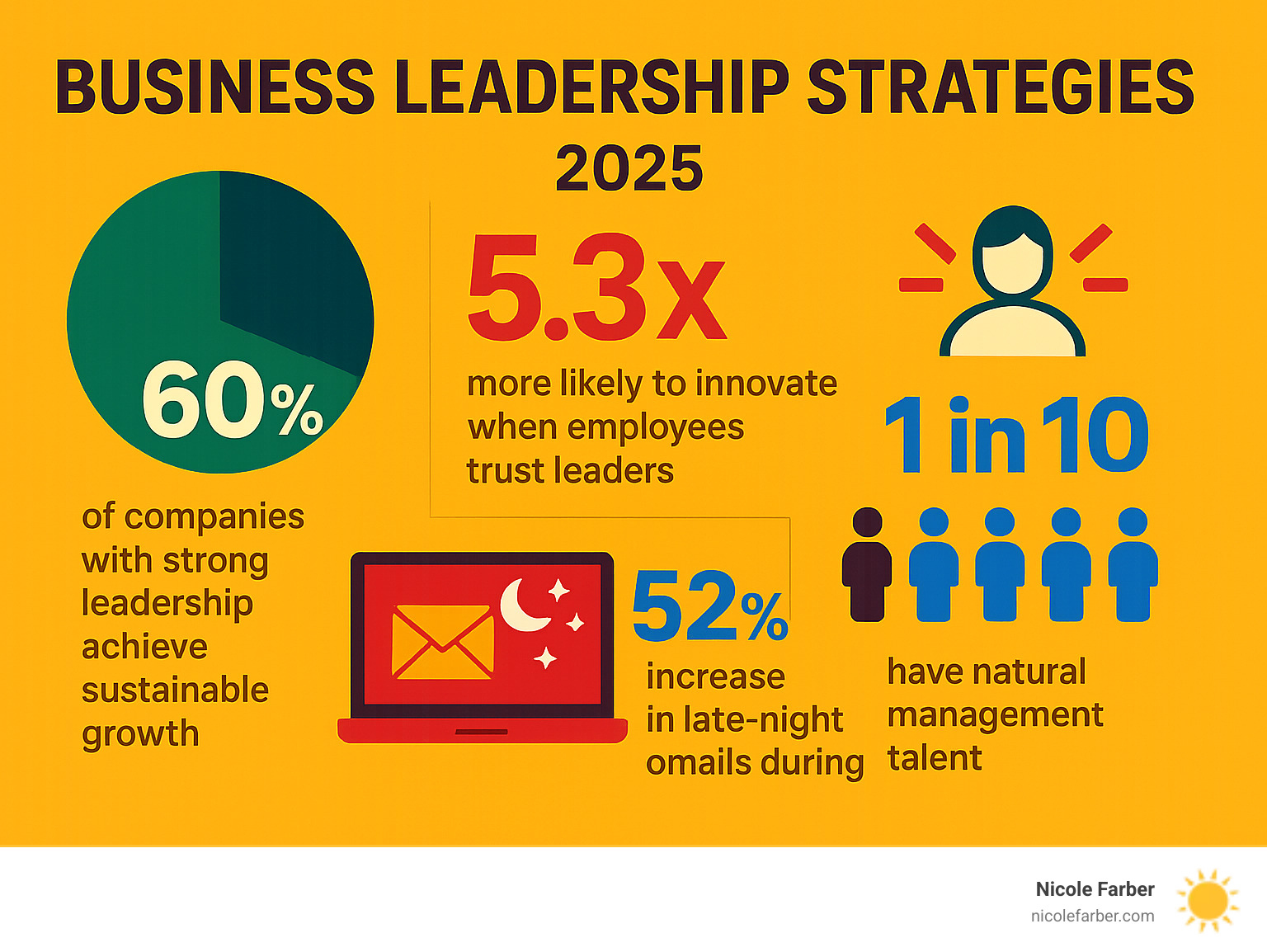Business Leadership Strategies to Transform Your Team
- Leadership
- In the News
- July 15, 2025
Why Business Leadership Strategies Are Your Competitive Advantage

Business leadership strategies are systematic approaches that help leaders inspire, direct and develop their teams toward clear goals. When vision, communication, delegation and role-modeling work in harmony they create high-performing cultures that fuel sustainable growth.
Key Business Leadership Strategies
- Define and Articulate Vision – Give every role a purpose
- Empower Through Delegation – Build trust while growing capability
- Communicate with Transparency – Keep information flowing in both directions
- Lead by Example – Model integrity, resilience and work ethic
- Adapt to Change – Learn quickly, pivot faster
- Foster Innovation – Encourage creativity and calculated risk-taking
The stakes are high. Gallup found only 1 in 10 people naturally excel at management, yet companies with strong leadership are 60 % more likely to achieve sustainable growth. Employees who trust their leaders are also 5.3 times more likely to innovate—an edge you can’t ignore.
As Nicole Farber, CEO of ENX2 Legal Marketing, I have watched the right leadership strategies transform struggling firms into market leaders. My blend of practical business acumen and faith-driven leadership helps organizations create lasting impact.

The Foundation: What is a Leadership Strategy and Why is it Crucial?

Think of a business leadership strategy as your organization’s GPS. It defines where you are going, why it matters and how leaders will guide people there. More than a set of management tips, it is a blueprint that links leadership development directly to business objectives—deciding what type of leaders you need, where they are needed and which skills will move the needle.
The outdated “power over” style of command-and-control is giving way to leading through purpose, care and collaboration. By focusing on doing good, developing people and mobilizing teams to solve tough problems, modern leaders create workplaces that attract talent and outperform rivals. More info about Entrepreneurship illustrates how this mindset transforms results.
The Impact on Culture, Talent and Financials
- Culture: Leaders who model desired behaviours and communicate openly create environments where people feel valued and perform at their best.
- Talent: High-calibre professionals seek out great leaders. When your strategy encourages growth and autonomy, recruiting becomes easier and retention rises.
- Financial performance: Companies with strong leadership are 60 % more likely to achieve sustainable growth.
- Innovation: Employees who trust leaders are 5.3 times more likely to propose bold ideas, fuelling competitive advantage.
In short, leadership isn’t a luxury—it is a strategic necessity.
Core Business Leadership Strategies for High-Performing Teams

Building high-performing teams requires more than good intentions; it demands the systematic implementation of proven leadership strategies. These are not just abstract concepts but actionable behaviors that shape daily interactions and long-term outcomes. When leaders consistently embody these traits, they create a ripple effect of excellence throughout the organization. Here are the essential traits and practices that separate exceptional leaders from the rest:
10 Essential Leadership Traits:
- Accountability – Taking responsibility for decisions and outcomes
- Empathy – Understanding and caring about team members’ perspectives
- Consistency – Maintaining steady behavior and decision-making patterns
- Transparency – Communicating openly and honestly
- Resilience – Bouncing back from setbacks and maintaining composure
- Adaptability – Adjusting strategies based on changing circumstances
- Integrity – Aligning actions with values and principles
- Vision – Seeing the bigger picture and inspiring others toward it
- Courage – Making difficult decisions and having tough conversations
- Humility – Recognizing limitations and learning from others
1. Define and Articulate a Compelling Vision
A compelling vision is the lighthouse that guides every decision. It gives clear direction, connects daily work to the company mission and energizes people when challenges arise.
Great visions answer three questions: Where are we headed? Why does it matter? How will we know we’ve arrived? Craft the vision collaboratively so team members feel ownership—then weave it into meetings, goal-setting and celebrations. When the “why” is front and center, alignment and motivation follow naturally.
2. Empower and Delegate Effectively
“If you want something done right, do it yourself” is leadership’s fastest route to burnout. Strategic delegation develops talent, boosts engagement and frees leaders for high-value work.
Match tasks to strengths, provide clear expectations and transfer real authority—not just workload. Stay available for guidance without micromanaging, and create simple check-ins to track progress. Empowered employees grow into future leaders, multiplying organizational capacity. Process Before Promotion dives deeper into building strength through systematic development.
3. Communicate with Transparency and Empathy
Communication builds bridges between strategy and execution. Transparency means sharing good news, bad news and the reasoning behind decisions. Empathy means caring about how information lands.
Practice active listening—put away distractions, ask clarifying questions and acknowledge feelings. Give feedback on behaviours, not personalities, and frame it as a mutual investment in growth. When people feel heard and informed, trust soars and problems surface early, saving time and money.
4. Lead by Example with Integrity and Resilience
Your team watches how you act under pressure more than what you say in meetings. Integrity is doing what you promise; resilience is bouncing back without blaming others.
Admit mistakes quickly, keep commitments large and small, and stay calm during setbacks. Consistent behaviour builds psychological safety, encouraging the same accountability and grit in your team. For more on building authentic presence, see Leadership.
Navigating the Modern Business Landscape

Markets, technology and employee expectations now shift faster than most strategic plans. Email traffic after 6 p.m. jumped 52 % in 2020, showing how blurred work boundaries have become.
Leaders that thrive adopt a learn-it-all mindset: staying curious, managing hybrid teams intentionally and integrating ESG considerations into everyday decisions. They treat digital disruption and social change as opportunities rather than threats. Chaos Brings Opportunity explores this perspective.
Common Pitfalls to Avoid
- Not delegating: creates bottlenecks and stalls growth.
- Avoiding conflict: lets small issues become crises.
- Second-guessing every decision: erodes team confidence.
- Resisting change: risks irrelevance in fast-moving markets.
- Ignoring well-being: accelerates burnout and turnover.

Continuous Growth: Sharpening Your Leadership Skills
Leadership development is a journey, not a box to tick. The most effective leaders invest in their own growth first.
Methods for Continuous Improvement
- Executive coaching provides customised feedback and accountability.
- Mentoring—both giving and receiving— accelerates learning.
- 360-degree feedback highlights blind spots.
- Formal programs offer structured skill-building.
- Self-reflection and mindfulness improve emotional regulation.
- Regularly seeking feedback keeps progress on track.
Combine several approaches for best results. How to Become an Effective Leader offers additional ideas.
Measuring Impact
Track KPIs such as productivity, retention, engagement and innovation. Supplement numbers with qualitative discussions. Improvements may take months, so stay patient and consistent.
Frequently Asked Questions about Business Leadership Strategies
How can a leader build trust with their team?
Trust grows from a foundation of consistency, transparency, and genuine care. Leaders build it by keeping their promises, sharing information openly (including challenges and the ‘why’ behind decisions), and showing a vested interest in each person’s professional and personal success. Admitting mistakes quickly and taking clear steps to fix them is also a powerful trust-builder.
What is the difference between leadership and management?
Management focuses on processes and tasks; leadership focuses on people and purpose. Great leaders do both—organising work efficiently while inspiring others to pursue a meaningful vision.
How can leaders prevent burnout in themselves and their teams?
Model healthy boundaries, delegate realistically and make it safe to discuss workload. Celebrate progress, encourage time off and recognise that purpose plus support are the best antidotes to sustained stress.
Conclusion
Business leadership strategies are the practical tools that turn average teams into high-performing powerhouses. By clarifying vision, empowering people, communicating openly and modelling integrity, you lay the groundwork for sustainable growth and innovation.
My own journey—as a single mother, CEO and motivational speaker—proves that these principles work in the real world. When leaders serve their teams, profitable results follow and workplaces become places where people flourish.
Ready to inspire your organisation? Explore leadership speaking engagements to inspire your team and start putting these strategies into daily practice.